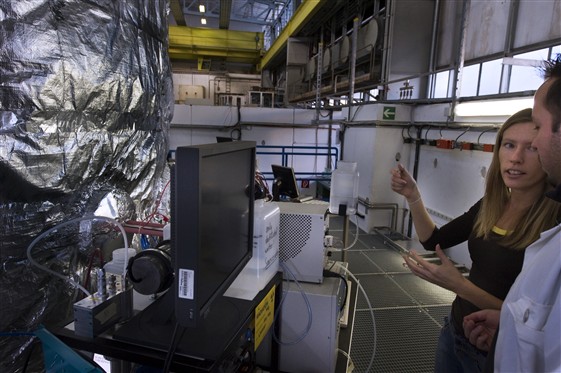Seriously, does anyone not think the Sun impacts the climate by now?
I know, I know, in the 1990s it was all carbon dioxide, but it's no longer 2006 - anyone gullible enough to believe the French and the Germans insisted on a 1990 date in the Kyoto protocol based on science, rather than the fact that Germany simply had to close a few post-unification Soviet-era factories from World War II and France had already brought more nuclear plants online to more easily meet their goals, well, they were too stupid to keep their money anyway.
But I guess there is still a debate that radiation, and the Sun's magnetic field, can be a driver of climate and temperature, so much so this barely-noticeable experiment is getting attention. But it is getting attention not for the science but rather that Rolf-Dieter Heuer, Director General of CERN since 2009, told a German newspaper
I have asked the colleagues to present the results clearly, but not to interpret them. That would go immediately into the highly political arena of the climate change debate. One has to make clear that cosmic radiation is only one of many parameters.Well, only now is it a given that there are multiple parameters? An offhand claim in a magazine about melting Himalayas was considered primary literature and included in the 2007 IPCC report but this has to be strictly data and no context, interpretation or framing for the public?
Cosmic rays hit us all of the time and, on their journey, they can create aerosols and therefore clouds. Can they create enough to impact the climate?
Well, that's what researchers mean by parameters. There are a lot of knobs turning in climate models but 5 years ago, when Science 2.0 started, deviating from the Cult of CO2 by discussing actual, you know, science, got us claims of 'Holocaust Deniers!' from the goofier science blogging constituency.
The CLOUD experiment (Cosmics Leaving Outdoor Droplets) is a chamber with air, ozone, ammonia, water, etc., the stuff clouds are made from. Then they hit it all with protons and monitor what happens in that artificial atmosphere.

The CLOUD experiment during the first beam run, December 2009. Credit: CERN
Really, that's it. I thought it was interesting but I was more excited about building a trebuchet with my kids (coming soon!) and the results were, as they said, preliminary. But climate change researchers who have never found any numerical climate model worth criticizing, no matter how suspect, are suddenly 'skeptical' of this one, despite it being in the planning stage for 10 years and conducted rather robustly compared to some ice core studies I have read.
This result set off the skeptical community and Heuer's comment did not help matters; why no interpretation now, why no discussion of parameters in 1996 when this idea was first introduced? Instead, IPCC chairman Bert Bolin said then, “I find the move from this pair scientifically extremely naive and irresponsible.”
No less an astute climate change expert than string theorist Luboš Motl was, just this once, a voice of reason on the matter, so you know how polarizing the discussion must be elsewhere:
One could perhaps understand if all scientists were similarly gagged and prevented from interpreting the results of their research in ways that could be relevant for policymaking. However, the main problem is that many people who are trying to work on very different phenomena in the climate are not prevented from interpreting - and indeed, overinterpreting and misinterpreting - their results that are often less serious, less reliable, and less rigorous, perhaps by orders of magnitude, than the observations by the European Organization for Nuclear Research.Well, it took a decade to get this thing off the ground so critics may be right that gagging is occurring selectively. Looking at the results objectively, since I got no dog in the climate change fight other than liking to slaughter every sacred cow I find, this is hardly worth getting excited about yet, it isn't evidence that the Sun's magnetic field is controlling cosmic rays and therefore our temperature far more than mankind and pollution are doing.
It is simply science at work - finally, after a decade and a half of circling the wagons, hypotheses that were dismissed as conspiratorial nonsense by zealots get a chance to live or die by the scientific method and not by aggressive posturing. Yes, these results introduce more questions than they answer, but claiming the issue was 'settled' did a lot more harm than good in implementing a responsible policy decision so it's time to try science.
If Heuer is simply the herald of a new age in climate research, where all participants are not 'interpreting' early results and publishing media talking points as fact six months before studies are released, that's good for everyone. The IPCC has had a disastrous decade so far and more rigor and less framing will be good for the entire world, perhaps physicists at the LHC are just the group to show them how things should be done.
Citation: Jasper Kirkby, Joachim Curtius, João Almeida, Eimear Dunne, Jonathan Duplissy, Sebastian Ehrhart, Alessandro Franchin, Stéphanie Gagné, Luisa Ickes, Andreas Kürten, Agnieszka Kupc, Axel Metzger, Francesco Riccobono, Linda Rondo, Siegfried Schobesberger, Georgios Tsagkogeorgas, Daniela Wimmer, Antonio Amorim, Federico Bianchi, Martin Breitenlechner, André David, Josef Dommen, Andrew Downard, Mikael Ehn, Richard C. Flagan, Stefan Haider, Armin Hansel, Daniel Hauser, Werner Jud, Heikki Junninen, Fabian Kreissl, Alexander Kvashin, Ari Laaksonen, Katrianne Lehtipalo, Jorge Lima, Edward R. Lovejoy, Vladimir Makhmutov, Serge Mathot, Jyri Mikkilä, Pierre Minginette, Sandra Mogo, Tuomo Nieminen, Antti Onnela, Paulo Pereira, Tuukka Petäjä, Ralf Schnitzhofer, John H. Seinfeld, Mikko Sipilä, Yuri Stozhkov, Frank Stratmann, Antonio Tomé, Joonas Vanhanen, Yrjo Viisanen, Aron Vrtala, Paul E. Wagner, Hansueli Walther, Ernest Weingartner, Heike Wex, Paul M. Winkler, Kenneth S. Carslaw, Douglas R. Worsnop, Urs Baltensperger&Markku Kulmala, 'Role of sulphuric acid, ammonia and galactic cosmic rays in atmospheric aerosol nucleation', Nature 476, 429–433 (25 August 2011) doi:10.1038/nature10343




Comments